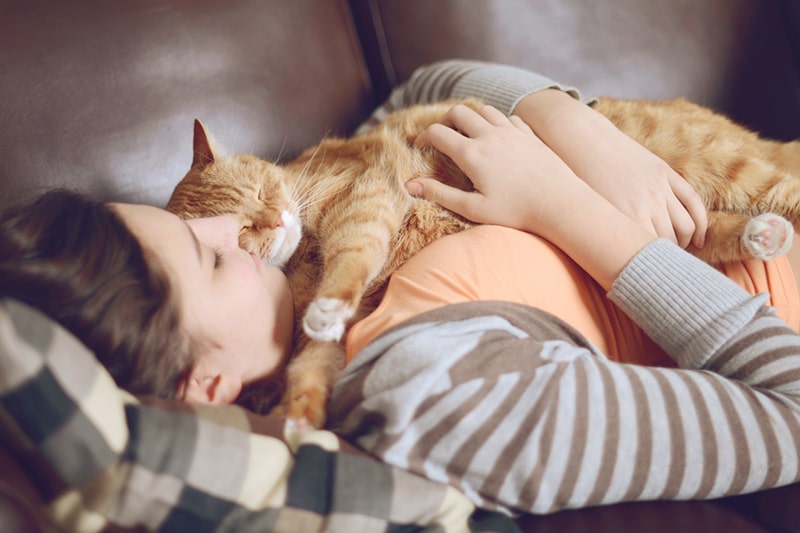Your Pet Ate What?!
Homes are filled with everyday objects toxic to pets. Learn how to keep your pet from eating things they shouldn’t and what to do in case they ingest something harmful.
Cats bring lots of love and laughs into a household. They curl up in our laps, circle our legs to greet us, and dart around the room chasing ping pong balls. They also come with costs that are important to consider before bringing home a new kitty.
If you're adopting a cat from a shelter, the first cost you're going to encounter is the adoption fee. These fees can vary by shelter and the age of the cat you're adopting, but you can expect to pay somewhere around $50 to $175. Some shelter cats may already be spayed or neutered, microchipped, or vaccinated (at least for their first round), which helps reduce your initial expenses.
Getting a cat from a breeder is more expensive. Some breeders may charge around $750 or more for a cat. Our strategic partner The American Society for the Prevention of Cruelty to Animals® (ASPCA®) recommends adopting from a shelter. There are so many wonderful cats and kittens in need of loving homes. Plus, you could be saving a life by adding a shelter cat to your family.
When you first get a cat, you'll need to invest in some essential items that range in price. There's also plenty of optional things you can purchase to help keep your cat happy and healthy.
The ASPCA estimates that the capital costs for a cat are around $365 including initial medical care and spaying or neutering.* Of course, this number can vary quite a bit depending on the items you decide to purchase.
Your cat will also need food and water bowls, but you can use some you have around the house if you like. Remember to clean them regularly to prevent harmful bacteria from building up.
The items on this list can make your cat more comfortable in your home, but they are nice-to-haves. It’s up to you to decide if you’d like to invest in them.

According to the ASPCA, you can plan to spend around $634 annually on your cat. This breaks down to around $53 a month. Their list of annual expenses includes:
The ASPCA also adds in $30 for miscellaneous costs for other things, such as catnip or an extra scratching mat. Obviously, these costs can range widely depending on the brands you choose and your cat's individual needs.
In addition, you may have other expenses depending on your lifestyle. For instance, you may need to hire someone to come by and check on your cat if you work long hours. Or you may need to pay a cat sitter or boarding facility if you go away for a vacation. If you live in an apartment or condo, you could be charged an extra fee for having a cat to cover any potential damage.
You may end up facing some unexpected costs, such as fixing household damage caused by your cat. Cats can rip up carpeting, scratch furniture, and cause other problems with those sharp nails. Some cats may also spray urine to mark their territory, which is a smell that can be tough to get out.
Additionally, cats can get hurt or sick, which can lead to expensive veterinary bills. Cats can miss a high jump and fracture a paw, swallow a bit of string they find on the floor and need surgery, or come down with an upper respiratory infection. It's impossible to predict how much an accident or illness might cost, but you can give yourself some financial cushion with a pet insurance plan.
The cost of cat insurance depends on the coverage you choose along with other factors, such as the age and breed of your cat. When you're shopping for pet insurance, be sure to balance coverage and cost. An inexpensive plan may seem appealing, but it won't do you much good if it doesn't cover the care your cat might need.
If you decide to purchase cat insurance, you'll need to add that cost to your list of cat expenses. Keep in mind that it can be easier to budget for a monthly premium than manage a costly veterinary bill that comes out of the blue.

While the costs of a cat can add up, there are some creative ways to save money.
You can also save on cat care by doing your best to keep your cat safe and healthy. For instance, make sure they're drinking plenty of water, eating the right amount of healthy food, and getting enough exercise. Additionally, you should cat-proof your home to help prevent accidents. And of course, shower them with love and attention, which can help keep you both happy.
* ASPCA®
The information presented in this article is for educational and informational purposes only and does not constitute or substitute for the advice of your veterinarian.
(opens new window)
An ASPCA® Pet Health Insurance plan can help you with eligible costs for covered conditions like surgery expenses for accidents and help provide peace of mind that your pet can receive the care they need. Check out our online resources to learn more about your insurance options and get a free quote today. The information presented in this article is for educational and informational purposes only and does not constitute or substitute for the advice of your veterinarian.